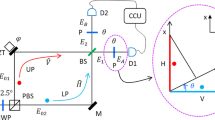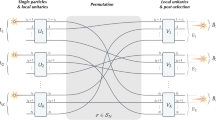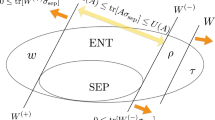Experimental Entanglement Swapping: Entangling Photons That Never Interacted
- Jian-Wei Pan ,
- Dik Bouwmeester ,
- Harald Weinfurter ,
- Anton Zeilinger
- Phys.Rev.Lett. 80 (1998) 18 , 3891
- Published: May 4, 1998
- 10.1103/PhysRevLett.80.3891

Citations per year
Experimental test of local hidden-variable theories.
- UC, Berkeley
- Phys.Rev.Lett. 28 (1972) 938-941
- 10.1103/PhysRevLett.28.938
Experimental violation of Bell's inequality based on phase and momentum
- Phys.Rev.Lett. 64 (1990) 2495-2498
- 10.1103/PhysRevLett.64.2495
Quantum Mechanics and Hidden Variables: A Test of Bell's Inequality by the Measurement of the Spin Correlation in Low-Energy Proton Proton Scattering
- Phys.Rev.D 14 (1976) 2543-2555
- 10.1103/PhysRevD.14.2543
Generation of Einstein-Podolsky-Rosen Pairs of Atoms
- Paris, Lab. Kastler Brossel
- Phys.Rev.Lett. 79 (1997) 1 , 1-5
- 10.1103/PhysRevLett.79.1
Teleporting an unknown quantum state via dual classical and Einstein-Podolsky-Rosen channels
- IBM Watson Res. Ctr.
- Montreal U.
- Montreal U. and
- Ecole Normale Supérieure, Paris
- Phys.Rev.Lett. 70 (1993) 1895-1899
- 10.1103/PhysRevLett.70.1895
‘‘Event-ready-detectors’’ Bell experiment via entanglement swapping
- M. Żukowski ,
- A. Zeilinger ,
- M.A. Horne ,
- Phys.Rev.Lett. 71 (1993) 26 , 4287
- 10.1103/PhysRevLett.71.4287
A Multiparticle generalization of entanglement swapping
- Imperial Coll., London
- Phys.Rev.A 57 (1998) 822
- quant-ph/9708004
- 10.1103/PhysRevA.57.822
- Of course, the complete two-photon state including both the spatial and the spin part has to obey bosonic symmetry. Thus, the two parts have to be either both symmetric or both antisymmetric. If the spatial part of the wave function is antisymmetric, the two photons will show fermionic statistics in their spatial behavior edit
- Physica B 175 (1991) 199
- H.J. Bernstein ,
- J.Mod.Opt. 41 (1994) 2375
Complementarity and the Quantum Eraser
- Innsbruck U.
- Phys.Rev.Lett. 75 (1995) 3034-3037
- 10.1103/PhysRevLett.75.3034
- M. Zukowski ,
- H. Weinfurter
- Annals N.Y.Acad.Sci. 755 (1995) 91
- J.G. Rarity
- Annals N.Y.Acad.Sci. 755 (1995) 624
New High-Intensity Source of Polarization-Entangled Photon Pairs
- Paul G. Kwiat ,
- Klaus Mattle ,
- Anton Zeilinger ,
- Alexander V. Sergienko
- Phys.Rev.Lett. 75 (1995) 24 , 4337
- 10.1103/PhysRevLett.75.4337
Dense Coding in Experimental Quantum Communication
- Innsbruck U. and
- Phys.Rev.Lett. 76 (1996) 25 , 4656-4659
- 10.1103/physrevlett.76.4656
- K. Mattle ,
- H. Weinfurter ,
- A. Zeilinger
- The polarization correlation is a function of the coincidence rates for polarization analysis of the two photons by parallel and by orthogonal polarizers. For a source emitting uncorrelated pairs either in the state |H〉1|V〉2 or in the state |V〉1|H〉2 this value is zero for analysis along ±45° whereas it reaches 1 for entangled pairs edit
Bell's theorem: Experimental tests and implications
- LLNL, Livermore and
- Rept.Prog.Phys. 41 (1978) 1881-1927
- 10.1088/0034-4885/41/12/002
- Comments Atom.Mol.Phys. 9 (1980) 121
- D.M. Greenberger ,
- A. Shimony ,
- Am.J.Phys. 58 (1990) 1131
- M. Zukowski
- Phys.Rev.Lett. 78 (1997) 3031
- Phys.Rev.A 57 (1998) 2208
Experimental quantum teleportation
- Nature 390 (1997) 575-579
- 10.1038/37539
Thank you for visiting nature.com. You are using a browser version with limited support for CSS. To obtain the best experience, we recommend you use a more up to date browser (or turn off compatibility mode in Internet Explorer). In the meantime, to ensure continued support, we are displaying the site without styles and JavaScript.
- View all journals
- Explore content
- About the journal
- Publish with us
- Sign up for alerts
- Published: 22 April 2012
Experimental delayed-choice entanglement swapping
- Xiao-song Ma 1 , 2 ,
- Stefan Zotter 1 nAff4 ,
- Johannes Kofler 1 nAff4 ,
- Rupert Ursin 1 ,
- Thomas Jennewein 1 nAff4 ,
- Časlav Brukner 1 , 3 &
- Anton Zeilinger 1 , 2 , 3
Nature Physics volume 8 , pages 479–484 ( 2012 ) Cite this article
8003 Accesses
158 Citations
153 Altmetric
Metrics details
- Optical physics
- Quantum mechanics
This article has been updated
Motivated by the question of which kind of physical interactions and processes are needed for the production of quantum entanglement, Peres has put forward the radical idea of delayed-choice entanglement swapping. There, entanglement can be ‘produced a posteriori , after the entangled particles have been measured and may no longer exist’. Here, we report the realization of Peres’s gedanken experiment. Using four photons, we can actively delay the choice of measurement—implemented through a high-speed tunable bipartite-state analyser and a quantum random-number generator—on two of the photons into the time-like future of the registration of the other two photons. This effectively projects the two already registered photons onto one of two mutually exclusive quantum states in which the photons are either entangled (quantum correlations) or separable (classical correlations). This can also be viewed as ‘quantum steering into the past’.
This is a preview of subscription content, access via your institution
Access options
Subscribe to this journal
Receive 12 print issues and online access
251,40 € per year
only 20,95 € per issue
Buy this article
- Purchase on SpringerLink
- Instant access to full article PDF
Prices may be subject to local taxes which are calculated during checkout

Similar content being viewed by others

Observations of the delayed-choice quantum eraser using coherent photons

Entangling three qubits without ever touching


Mirrored entanglement witnesses
Change history, 26 april 2012.
In the version of this Article originally published online, the definition of the witness operator given in the paragraph after equation (4) was incorrect. This error has been corrected in all versions of the Article.
Einstein, A., Podolsky, B. & Rosen, N. Can quantum-mechanical description of physical reality be considered complete? Phys. Rev. 47 , 777–780 (1935).
Article ADS Google Scholar
Schrödinger, E. Die gegenwärtige Situation in der Quantenmechanik. Naturwissenschaften 23 , 807–812; 823–828; 844–849 (1935). English translation in Proc. Am. Philos. Soc. 124, (1980), reprinted in Wheeler, J. A. & Zurek, W. H. (eds) Quantum Theory and Measurement 152–167 (Princeton Univ. Press,1984).
Article Google Scholar
Žukowski, M., Zeilinger, A., Horne, M. A. & Ekert, A. K. ‘Event-ready-detectors’ Bell experiment via entanglement swapping. Phys. Rev. Lett. 71 , 4287–4290 (1993).
Peres, A. Delayed choice for entanglement swapping. J. Mod. Opt. 47 , 139–143 (2000).
Article ADS MathSciNet Google Scholar
Cohen, O. Counterfactual entanglement and nonlocal correlations in separable states. Phys. Rev. A 60 , 80–84 (1999).
Jennewein, T., Achleitner, U., Weihs, G., Weinfurter, H. & Zeilinger, A. A fast and compact quantum random number generator. Rev. Sci. Instrum. 71 , 1675–1680 (2000).
Bohr, N. in Quantum Theory and Measurement (eds Wheeler, J. A. & Zurek, W. H.) 9–49 (Princeton Univ. Press, 1984).
Google Scholar
Wheeler, J. A. Mathematical Foundations of Quantum Theory 9–48 (Academic, 1978).
Book Google Scholar
Wheeler, J. A. in Quantum Theory and Measurement (eds Wheeler, J. A. & Zurek, W. H.) 182–213 (Princeton Univ. Press, 1984).
Alley, C. O., Jacubowicz, O. G. & Wickes, W. C. in Proc. Second International Symposium on the Foundations of Quantum Mechanics (ed. Narani, H.) 36–47 (Physics Society of Japan, 1987).
Hellmut, T., Walther, H., Zajonc, A. G. & Schleich, W. Delayed-choice experiments in quantum interference. Phys. Rev. A 35 , 2532–2541 (1987).
Baldzuhn, J., Mohler, E. & Martienssen, W. A wave-particle delayed-choice experiment with a single-photon state. Z. Phys. B 77 , 347–352 (1989).
Kim, Y-H., Yu, R., Kulik, S., Shih, Y. & Scully, M. O. Delayed ‘choice’ quantum eraser. Phys. Rev. Lett. 84 , 1–4 (2000).
Jacques, V. et al. Experimental realization of Wheeler’s delayed-choice gedanken experiment. Science 315 , 966–968 (2007).
Jacques, V. et al. Delayed-choice test of quantum complementarity with interfering single photons. Phys. Rev. Lett. 100 , 220402 (2008).
Jennewein, T., Weihs, G., Pan, J-W. & Zeilinger, A. Experimental nonlocality proof of quantum teleportation and entanglement swapping. Phys. Rev. Lett. 88 , 017903 (2001).
Sciarrino, F., Lombardi, E., Milani, G. & De Martini, F. Delayed-choice entanglement swapping with vacuum–one-photon quantum states. Phys. Rev. A 66 , 024309 (2002).
Schrödinger, E. Discussion of probability relations between separated systems. Proc. Camb. Phil. Soc. 31 , 555–563 (1935).
Aspect, A., Dalibard, J. & Roger, G. Experimental test of Bell’s inequalities using time-varying analyzers. Phys. Rev. Lett. 49 , 1804–1807 (1982).
Weihs, G. et al. Violation of Bell’s inequality under strict Einstein locality conditions. Phys. Rev. Lett. 81 , 5039–5043 (1998).
Scheidl, T. et al. Violation of local realism with freedom of choice. Proc. Natl Acad. Sci. USA 107 , 19708–19713 (2010).
Coffman, V., Kundu, J. & Wootters, W. K. Distributed entanglement. Phys. Rev. A 61 , 052306 (1993).
Pan, J-W., Bouwmeester, D., Weinfurter, H. & Zeilinger, A. Experimental entanglement swapping: Entangling photons that never interacted. Phys. Rev. Lett. 80 , 3891–3894 (1998).
Riebe, M. et al. Deterministic quantum teleportation with atoms. Nature 429 , 734–737 (2004).
Barrett, M. D. et al. Deterministic quantum teleportation of atomic qubits. Nature 429 , 737 (2004).
Matsukevich, D. N., Maunz, P., Moehring, D. L., Olmschenk, S. & Monroe, C. Bell inequality violation with two remote atomic qubits. Phys. Rev. Lett. 100 , 150404 (2008).
Halder, M. et al. Entangling independent photons by time measurement. Nature Phys. 3 , 692–695 (2007).
Yuan, Z-S. et al. Experimental demonstration of a BDCZ quantum repeater node. Nature 454 , 1098–1101 (2008).
Kaltenbaek, R., Prevedel, R., Aspelmeyer, M. & Zeilinger, A. High-fidelity entanglement swapping with fully independent sources. Phys. Rev. A. 79 , 040302 (2009).
Briegel, H-J., Duer, W., Cirac, J. I. & Zoller, P. Quantum repeaters: The role of imperfect local operations in quantum communication. Phys. Rev. Lett. 81 , 5932–5935 (1998).
Duan, L-M., Lukin, M. D., Cirac, J. I. & Zoller, P. Long-distance quantum communication with atomic ensembles and linear optics. Nature 414 , 413–418 (2001).
Chen, Y-A. et al. Experimental quantum secret sharing and third-man quantum cryptography. Phys. Rev. Lett. 95 , 200502 (2005).
Simon, C. & Irvine, W. T. M. Robust long-distance entanglement and a loophole-free Bell test with ions and photons. Phys. Rev. Lett. 91 , 110405 (2003).
Greenberger, D. M., Horne, M. & Zeilinger, A. Bell theorem without inequalities for two particles. I. Efficient detectors. Phys. Rev. A. 78 , 022110 (2008).
Greenberger, D. M., Horne, M., Zeilinger, A. & Žukowski, M. Bell theorem without inequalities for two particles. II. Inefficient detectors. Phys. Rev. A. 78 , 022111 (2008).
Hong, C. K., Ou, Z. Y. & Mandel, L. Measurement of subpicosecond time intervals between two photons by interference. Phys. Rev. Lett. 59 , 2044–2046 (1987).
Mattle, K., Weinfurter, H., Kwiat, P. G. & Zeilinger, A. Dense coding in experimental quantum communication. Phys. Rev. Lett. 76 , 4656–4659 (1996).
Jennewein, T., Aspelmeyer, M., Brukner, Č. & Zeilinger, A. Experimental proposal of switched delayed-choice for entanglement swapping. Int. J. Quant. Info. 3 , 73–79 (2005).
Kwiat, P. G. et al. New high-intensity source of polarization-entangled photon pairs. Phys. Rev. Lett. 75 , 4337–4341 (1995).
Brukner, Č., Aspelmeyer, M. & Zeilinger, A. Complementarity and information in delayed-choice for entanglement swapping. Found. Phys. 35 , 1909–1919 (2005).
Ma, X-S. et al. A high-speed tunable beam splitter for feed-forward photonic quantum information processing. Opt. Express 19 , 22723–22730 (2011).
Gühne, O. et al. Detection of entanglement with few local measurements. Phys. Rev. A 66 , 062305 (2002).
Zhang, Q. et al. Experimental quantum teleportation of a two-qubit composite system. Nature Phys. 2 , 678–682 (2006).
Gühne, O. & Toth, G. Entanglement detection. Phys. Rep. 474 , 1–75 (2009).
Žukowski, M., Zeilinger, A. & Weinfurter, H. Entangling photons radiated by independent pulsed sources. Ann. N.Y. Acad. Sci. 755 , 91–102 (1995).
Download references
Acknowledgements
We are grateful to N. Tetik and A. Qarry for help during the early stages of the experiment, and M. Aspelmeyer and P. Walther for fruitful discussions. We acknowledge support from the European Commission, Q-ESSENCE (No. 248095), ERC Advanced Senior Grant (QIT4QAD) and the John Templeton Foundation, as well as SFB-FOQUS and the Doctoral Program CoQuS of the Austrian Science Fund (FWF).
Author information
Stefan Zotter, Johannes Kofler & Thomas Jennewein
Present address: Present addresses: Center for Medical Physics and Biomedical Engineering, Medical University of Vienna, Waehringer Guertel 18-20, A-1090 Vienna, Austria (S.Z.); Max Planck Institute of Quantum Optics, Hans-Kopfermann-Str. 1, 85748 Garching/Munich, Germany (J.K.); Institute for Quantum Computing and Department of Physics and Astronomy, University of Waterloo, 200 University Ave W., Waterloo, Ontario, Canada N2L3G1 (T.J.),
Authors and Affiliations
Institute for Quantum Optics and Quantum Information (IQOQI), Austrian Academy of Sciences, Boltzmanngasse 3, A-1090 Vienna, Austria
Xiao-song Ma, Stefan Zotter, Johannes Kofler, Rupert Ursin, Thomas Jennewein, Časlav Brukner & Anton Zeilinger
Vienna Center for Quantum Science and Technology (VCQ), Faculty of Physics, University of Vienna, Boltzmanngasse 5, A-1090 Vienna, Austria
Xiao-song Ma & Anton Zeilinger
Faculty of Physics, University of Vienna, Boltzmanngasse 5, A-1090 Vienna, Austria
Časlav Brukner & Anton Zeilinger
You can also search for this author in PubMed Google Scholar
Contributions
X-s.M. designed and carried out the experiment and analysed data. S.Z. provided experimental assistance. J.K. provided the theoretical analysis and analysed data. R.U. provided experimental and conceptual assistance. T.J. conceived the research, planned and performed the experiment and analysed data. Č.B. provided theoretical suggestions and analysis. A.Z. conceived the research, designed the experiment and supervised the project. All authors wrote the manuscript.
Corresponding authors
Correspondence to Xiao-song Ma or Anton Zeilinger .
Ethics declarations
Competing interests.
The authors declare no competing financial interests.
Supplementary information
Supplementary information.
Supplementary Information (PDF 599 kb)
Rights and permissions
Reprints and permissions
About this article
Cite this article.
Ma, Xs., Zotter, S., Kofler, J. et al. Experimental delayed-choice entanglement swapping. Nature Phys 8 , 479–484 (2012). https://doi.org/10.1038/nphys2294
Download citation
Received : 23 September 2011
Accepted : 16 March 2012
Published : 22 April 2012
Issue Date : June 2012
DOI : https://doi.org/10.1038/nphys2294
Share this article
Anyone you share the following link with will be able to read this content:
Sorry, a shareable link is not currently available for this article.
Provided by the Springer Nature SharedIt content-sharing initiative
This article is cited by
Delayed choice experiments: an analysis in forward time.
- Marijn Waaijer
- Jan Van Neerven
Quantum Studies: Mathematics and Foundations (2024)
Quantum causality emerging in a delayed-choice quantum Cheshire Cat experiment with neutrons
- Richard Wagner
- Wenzel Kersten
- Yuji Hasegawa
Scientific Reports (2023)
Indefinite causal order with fixed temporal order for electrons and positrons
- Aurélien Drezet
Quantum Studies: Mathematics and Foundations (2023)
Entanglement and the Path Integral
- Ken Wharton
Foundations of Physics (2023)
Experimental assessment of physical realism in a quantum-controlled device
- Pedro R. Dieguez
- Jéferson R. Guimarães
- Roberto M. Serra
Communications Physics (2022)
Quick links
- Explore articles by subject
- Guide to authors
- Editorial policies
Sign up for the Nature Briefing newsletter — what matters in science, free to your inbox daily.

IMAGES
COMMENTS
May 4, 1998 · We experimentally entangle freely propagating particles that never physically interacted with one another or which have never been dynamically coupled by any other means. This demonstrates that quantum entanglement requires the entangled particles neither to come from a common source nor to have interacted in the past. In our experiment we take two pairs of polarization entangled photons and ...
According to the entanglement swapping scheme, upon projection of photons 2 and 3 into the jC2l 23 state, photons 1 and 4 should be projected into the jC2l 14 state. To verify that this entangled state is obtained, we have to analyze the polarization correlations between photons 1 and 4 conditioned on coincidences between the detectors
1.5.2. Experimental Entanglement Swapping: Entangling Photons That Never Interacted[13] We experimentally entangle freely propagating particles that never physically interacted with one another or which have never been dynamically coupled by any other means.
Of course, the complete two-photon state including both the spatial and the spin part has to obey bosonic symmetry. Thus, the two parts have to be either both symmetric or both antisymmetric. If the spatial part of the wave function is antisymmetric, the two photons will show fermionic statistics in their spatial behavior.
May 4, 1998 · DOI: 10.1103/PHYSREVLETT.80.3891 Corpus ID: 123669961; Experimental Entanglement Swapping: Entangling Photons That Never Interacted @article{Pan1998ExperimentalES, title={Experimental Entanglement Swapping: Entangling Photons That Never Interacted}, author={Jian-Wei Pan and Dirk Bouwmeester and Harald Weinfurter and Anton Zeilinger}, journal={Physical Review Letters}, year={1998}, volume={80 ...
May 22, 2013 · The role of the timing and order of quantum measurements is not just a fundamental question of quantum mechanics, but also a puzzling one. Any part of a quantum system that has finished evolving can be measured immediately or saved for later, without affecting the final results, regardless of the continued evolution of the rest of the system. In addition, the nonlocality of quantum mechanics ...
May 4, 1998 · This demonstrates that quantum entanglement requires the entangled particles neither to come from a common source nor to have interacted in the past. In our experiment we take two pairs of polarization entangled photons and subject one photon from each pair to a Bell-state measurement.
this even holds if the “entangling” Bell-state measurement is performed after photons 0 and 3 have already been registered. Entanglement swapping was shown [5] in a previous experiment, yet the low photon-pair visibility prevented a violation of a Bell’s inequality [6] for photons 0 and 3, which is a definitive test.
swapping [15] and multistage entanglement swapping [16], entangled photons that were separated spatially, but not temporally, i.e., all the photons that were entangled, existed and were measured at the same time. In this work we demonstrate how the time at which quantum measurements are taken and their order has no effect on the outcome of a ...
Apr 22, 2012 · In the entanglement swapping 1,2,3 procedure, two pairs of entangled photons are produced, and one photon from each pair is sent to Victor. The two other photons from each pair are sent to Alice ...